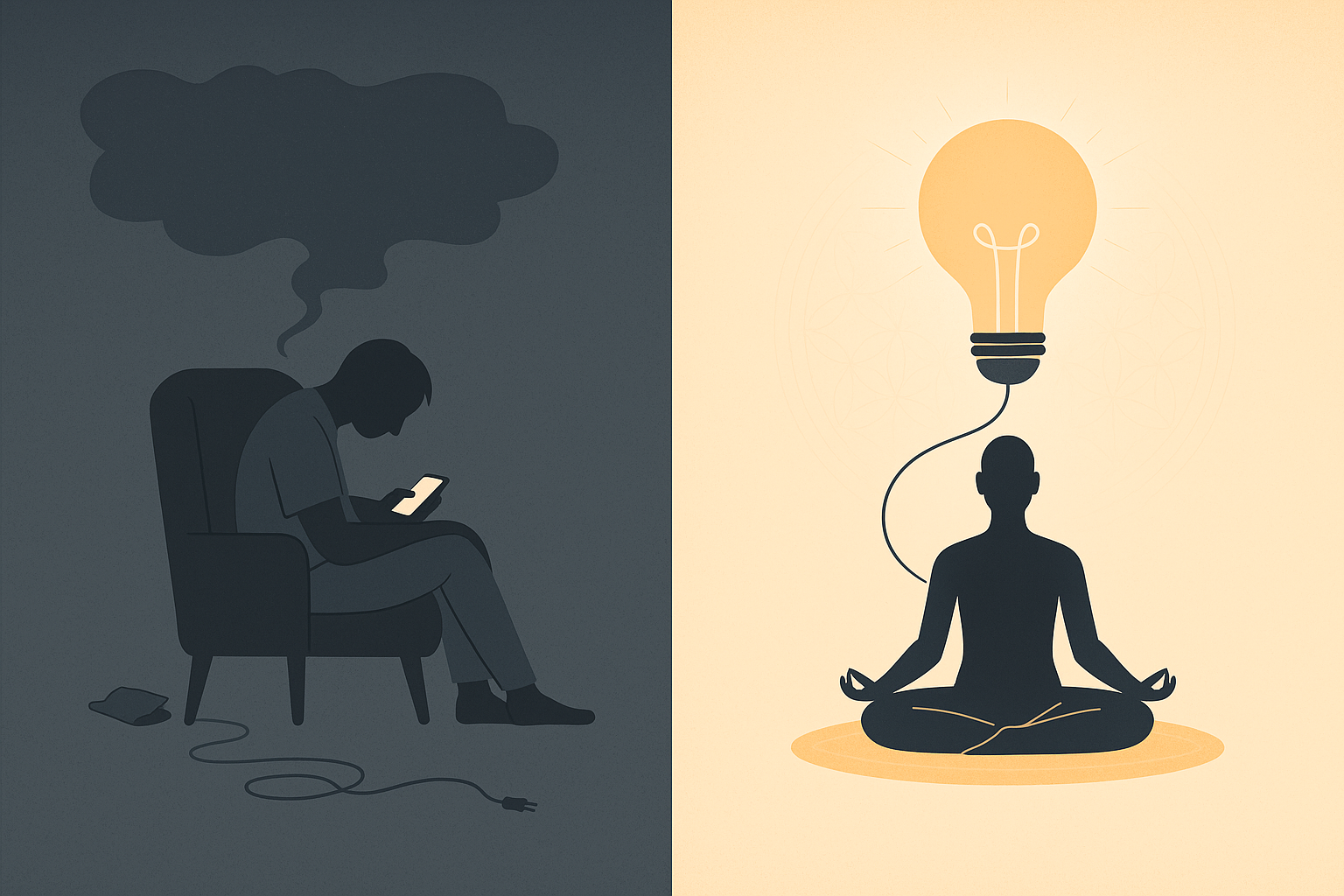In today’s fast-paced world, staying productive and motivated often feels like a constant uphill battle. While deadlines loom and aspirations call, many people struggle with a persistent lack of energy, procrastination, or an inability to stay consistent. This deep-seated tiredness or lack of enthusiasm isn’t just physical — it’s often a more profound psychological or even spiritual fatigue that modern productivity tools can’t fix.
That’s where the ancient wisdom of Yog offers a timeless and holistic solution. Yog doesn’t simply provide surface-level motivation; it helps eliminate the root causes of lethargy by restoring balance between body, mind, and energy. It aligns our inner system so that self-motivation arises naturally, not from pressure or guilt, but from within.
Let’s explore how we can understand and overcome laziness through the lens of Yog, and adopt practices that not only energize the body but also awaken the spirit.
Table Of Contents
- Understanding Lethargy Through the Yogic Lens
- The Yogic Path to Lasting Self-Motivation
- Daily Yogic Practices to Beat Lethargy
- Awakening Breath with Pranayama
- Mudras for Motivation
- Yogic Lifestyle Habits to Stay Energetic All Day
- Mind Training Through Dhyana (Meditation) and Sankalpa
- What to Do on Days You Still Feel Unmotivated
- Wrapping Up: Turn Inertia Into Inner Light
— Understanding Lethargy Through the Yogic Lens
In Yogic philosophy, the universe — including our own body and mind — operates under the influence of three primary energies or “gunas”: Sattva, Rajas, and Tamas.
- Sattva is the energy of clarity, harmony, light, and balance.
- Rajas is the energy of action, movement, desire, and restlessness.
- Tamas is the energy of inertia, darkness, confusion, and heaviness.
Lethargy is not merely a lack of physical stamina. It’s a sign that Tamas is dominating your inner environment. It shows up as procrastination, oversleeping, mental fog, lack of motivation, and sometimes even emotional numbness. In such a state, even thinking about a to-do list can feel overwhelming.
The problem isn’t that you’re lazy — the problem is that your internal energies are out of alignment. Instead of fighting yourself, Yog invites you to observe, understand, and gently transform that energy.
By gradually reducing tamas and increasing sattva through disciplined practices, laziness dissolves, and self-motivation flows in naturally. This is not a quick fix — it’s a genuine, lasting inner transformation.
— The Yogic Path to Lasting Self-Motivation
One of the core teachings of Yog is that energy precedes action. When our prana (vital energy) is stagnant or low, it isn’t easy to take inspired action. Modern society often tells us to push harder, hustle more, or find external motivation. But Yog teaches that true, lasting motivation comes not from outside inspiration, but from inner alignment.
In the yogic path, self-motivation is a result of balanced gunas, especially the rise of sattva. When sattva dominates, you begin to feel light, alert, enthusiastic, and focused — not through willpower alone, but through the natural flow of energy.
This is why Yog emphasizes consistency, discipline (tapas), and mindful living over sporadic bursts of motivation. It trains the body and mind to remain stable, alert, and connected to a deeper purpose.
Through regular practice, you begin to experience the subtle but powerful difference between pushing yourself to do something and being pulled by purpose toward your Dharma.
— Daily Yogic Practices to Beat Lethargy
To overcome tamas and stimulate healthy inner energy, the body must move and breathe in specific ways. Yog offers a perfect toolbox for this: Asanas (postures), Pranayama (breathwork), and Mudras (gestures).
Energizing Asanas
Specific yoga postures are particularly beneficial in stimulating the nervous system, enhancing blood circulation, and alleviating inertia.
- Surya Namaskar (Sun Salutation): This is a full-body energizing sequence that synchronizes breath with movement, promoting overall well-being and vitality. Practicing 5 to 12 rounds in the morning increases metabolism, warms up the spine, and kickstarts both body and mind into action.
- Tadasana (Mountain Pose): Though simple, this pose teaches you to stand tall with awareness. It helps improve posture, breath awareness, and grounding.
- Dhanurasana (Bow Pose): This backbend opens the chest, activates digestion, and removes physical sluggishness.
- Ustrasana (Camel Pose): A powerful heart-opening pose that invigorates the spinal cord and boosts emotional well-being.
Practicing these asanas for just 15–30 minutes daily can help reprogram your body from a state of dormancy to one of alertness. The key is not intensity, but regularity.
— Awakening Breath with Pranayama
Breath is prana, and tamas thrives when prana is blocked or low. The proper pranayama techniques can lift energy almost instantly.
- Bhastrika (Bellows Breath): This fast, forceful breath helps remove phlegm, awaken inner fire, and oxygenate the brain.
- Kapalbhati (Skull-Shining Breath): A detoxifying technique that clears brain fog and sharpens mental alertness.
- Nadi Shodhana (Alternate Nostril Breathing): Balances both hemispheres of the brain, reduces anxiety, and restores mental clarity.
Start slow. Even 5 minutes a day can create profound shifts in energy. Over time, these breathing practices help dissolve the heavy layer of tamas from the nervous system, instilling clarity and drive.
— Mudras for Motivation
Hand gestures, or mudras, can stimulate energy pathways in the body and affect mood and vitality.
- Prana Mudra: Made by touching the tips of the ring and little fingers to the thumb, it activates dormant energy and strengthens immunity.
- Gyan Mudra: The classic mudra for wisdom, it enhances focus and clarity when practiced in conjunction with meditation.
Mudras are subtle yet powerful and can be practiced at any time, whether sitting, working, or walking.
— Yogic Lifestyle Habits to Stay Energetic All Day
True transformation happens not just on the mat, but in how we live moment to moment. The Yogic lifestyle is designed to minimize tamas and cultivate sattva — the state in which self-motivation becomes natural and effortless.
Wake Up During Brahmamuhurta
The time between 3:30 am and 5:30 am is considered Brahmamuhurta — the most spiritually potent part of the day. Waking during this period helps align your biological clock with cosmic rhythms. The mind is calm, and the air is rich with prana. Starting your day in this window with yoga, pranayama, or silence sets the tone for alertness and purpose.
Follow a Sattvic Diet
What you eat directly influences your energy levels and state of mind. A Sattvic diet is light, fresh, and filled with life force energy, or prana. It includes fruits, vegetables, whole grains, nuts, seeds, dairy (in moderation), and herbal teas.
Avoid heavy, fried, leftover, or excessively spicy and sweet foods, as they increase tamas. Also, avoid cold milk at night, especially if you suffer from conditions like diabetes — it can increase mucus and sluggishness.
Eating at regular intervals, chewing slowly, and being mindful during meals are subtle yet powerful practices that can boost pranic absorption and digestion.
Maintain Clean Surroundings
According to the Yogic principle of saucha (cleanliness), your external environment affects your internal state. A cluttered or dirty space increases the quality of tamas. Clean, organized, and serene surroundings foster sattva and make it easier to stay mentally clear and motivated.
Limit Digital Overload
Today’s screen-heavy lifestyle constantly bombards the mind with fragmented attention. Overconsumption of social media, especially mindless scrolling, directly feeds tamas. Schedule time away from screens — and when you do engage, choose uplifting content.
Use your phone as a tool, not a trap. A short daily digital detox can renew your energy more than an hour-long nap.
Engage in Seva (Selfless Service)
Helping others without expectation softens the ego and invites inner joy. Seva (service) is one of the most underrated ways to overcome lethargy. When we work for others, the heart opens and tamas dissolves into purposeful action.
— Mind Training Through Dhyana (Meditation) and Sankalpa
Even when your body is active and your habits are clean, the mind can remain unfocused or restless. This is where Dhyana (meditation) comes in. It is the most subtle and powerful tool to train the mind to observe its patterns, reprogram limiting beliefs, and stay connected to inner clarity.
Just 10–20 minutes of meditation each morning helps quiet the noise of distractions and align your actions with higher intention.
Pair meditation with a Sankalpa — a positive, affirming statement of intent. Unlike resolutions driven by pressure, a Sankalpa is planted in the meditative state, where the subconscious mind is most receptive.
Examples:
- “I move through my day with clarity and enthusiasm.”
- “My energy flows freely and purposefully.”
- “I act with commitment, not just emotion.”
This daily practice of Dhyana and Sankalpa creates a self-sustaining source of motivation. You no longer chase productivity; instead, you become a source of calm, focused energy.
Adding Japa (mantra repetition) — such as “Om Namah Shivaya” or “So Hum” — further anchors your attention and elevates your frequency.
— What to do on Days You Still Feel Unmotivated
Despite best efforts, there will be days when energy dips. You may feel like skipping practice, staying in bed, or losing hope. That’s okay. Even nature has its winter. What matters is how you respond.
Yog doesn’t promise that motivation will be constant. It teaches that you don’t need motivation to act — you only need Tapas.
Tapas, or inner discipline, is the sacred fire that keeps you walking even when you don’t feel like it. It’s not rigid or punishing. It’s loving, respectful self-discipline that says, “I honor my path even when it’s hard.”
On tough days:
- Do a lighter practice instead of skipping entirely.
- Sit in stillness even for 2 minutes.
- Repeat your Sankalpa or mantra silently.
- Remember that action leads to energy, not the other way around.
Quote from the Bhagavad Gita:
“You have the right to perform your prescribed duties, but you are not entitled to the fruits of your actions.”
(Karmanye Vadhikaraste Ma Phaleshu Kadachana – BG 2.47)
Focus on the action, not the outcome. One step a day — that’s enough.
— Wrapping Up: Turn Inertia Into Inner Light
Overcoming laziness isn’t about fighting yourself; it’s about embracing a new perspective. It’s about creating the conditions for your energy to rise, naturally and gently.
Through Yog, you learn to transform tamas into movement, rajas into conscious effort, and finally awaken sattva — the light of clarity, joy, and inspiration. The tools are ancient, but their application is timeless: move your body with intention, breathe deeply, eat consciously, think clearly, serve humbly, and sit in silence.



